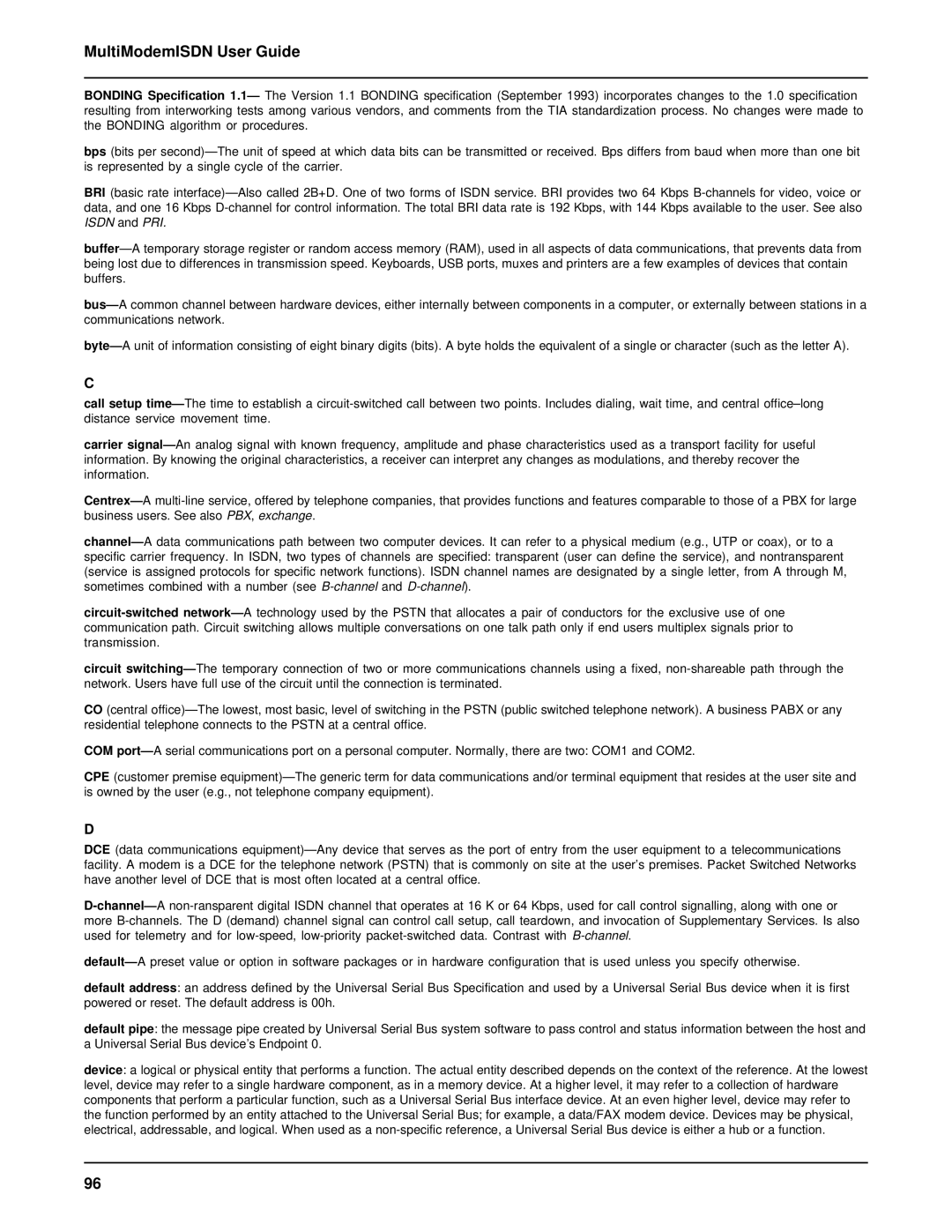MultiModemISDN User Guide
BONDING Specification 1.1— The Version 1.1 BONDING specification (September 1993) incorporates changes to the 1.0 specification resulting from interworking tests among various vendors, and comments from the TIA standardization process. No changes were made to the BONDING algorithm or procedures.
bps (bits per second)— The unit of speed at which data bits can be transmitted or received. Bps differs from baud when more than one bit is represented by a single cycle of the carrier.
BRI (basic rate interface)— Also called 2B+D. One of two forms of ISDN service. BRI provides two 64 Kbps B-channels for video, voice or data, and one 16 Kbps D-channel for control information. The total BRI data rate is 192 Kbps, with 144 Kbps available to the user. See also ISDN and PRI.
buffer— A temporary storage register or random access memory (RAM), used in all aspects of data communications, that prevents data from being lost due to differences in transmission speed. Keyboards, USB ports, muxes and printers are a few examples of devices that contain buffers.
bus—A common channel between hardware devices, either internally between components in a computer, or externally between stations in a communications network.
byte—A unit of information consisting of eight binary digits (bits). A byte holds the equivalent of a single or character (such as the letter A).
C
call setup time—The time to establish a circuit-switched call between two points. Includes dialing, wait time, and central office–long distance service movement time.
carrier signal—An analog signal with known frequency, amplitude and phase characteristics used as a transport facility for useful information. By knowing the original characteristics, a receiver can interpret any changes as modulations, and thereby recover the information.
Centrex—A multi-line service, offered by telephone companies, that provides functions and features comparable to those of a PBX for large business users. See also PBX, exchange.
channel—A data communications path between two computer devices. It can refer to a physical medium (e.g., UTP or coax), or to a specific carrier frequency. In ISDN, two types of channels are specified: transparent (user can define the service), and nontransparent (service is assigned protocols for specific network functions). ISDN channel names are designated by a single letter, from A through M, sometimes combined with a number (see B-channeland D-channel).
circuit-switchednetwork—A technology used by the PSTN that allocates a pair of conductors for the exclusive use of one communication path. Circuit switching allows multiple conversations on one talk path only if end users multiplex signals prior to transmission.
circuit switching—The temporary connection of two or more communications channels using a fixed, non-shareable path through the network. Users have full use of the circuit until the connection is terminated.
CO (central office)— The lowest, most basic, level of switching in the PSTN (public switched telephone network). A business PABX or any residential telephone connects to the PSTN at a central office.
COM port—A serial communications port on a personal computer. Normally, there are two: COM1 and COM2.
CPE (customer premise equipment)— The generic term for data communications and/or terminal equipment that resides at the user site and is owned by the user (e.g., not telephone company equipment).
D
DCE (data communications equipment)— Any device that serves as the port of entry from the user equipment to a telecommunications facility. A modem is a DCE for the telephone network (PSTN) that is commonly on site at the user’s premises. Packet Switched Networks have another level of DCE that is most often located at a central office.
D-channel—A non-ransparent digital ISDN channel that operates at 16 K or 64 Kbps, used for call control signalling, along with one or more B-channels. The D (demand) channel signal can control call setup, call teardown, and invocation of Supplementary Services. Is also used for telemetry and for low-speed, low-priority packet-switched data. Contrast with B-channel.
default—A preset value or option in software packages or in hardware configuration that is used unless you specify otherwise.
default address: an address defined by the Universal Serial Bus Specification and used by a Universal Serial Bus device when it is first powered or reset. The default address is 00h.
default pipe: the message pipe created by Universal Serial Bus system software to pass control and status information between the host and a Universal Serial Bus device’s Endpoint 0.
device: a logical or physical entity that performs a function. The actual entity described depends on the context of the reference. At the lowest level, device may refer to a single hardware component, as in a memory device. At a higher level, it may refer to a collection of hardware components that perform a particular function, such as a Universal Serial Bus interface device. At an even higher level, device may refer to the function performed by an entity attached to the Universal Serial Bus; for example, a data/FAX modem device. Devices may be physical, electrical, addressable, and logical. When used as a non-specific reference, a Universal Serial Bus device is either a hub or a function.

